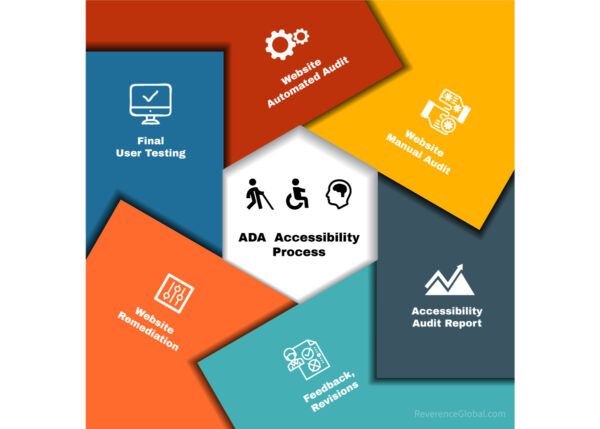What is ADA and what does it have to do with the internet?
Since the Americans with Disabilities Act (ADA) was passed in 1990, Congress has worked to ensure that businesses and public service providers make necessary changes to support people with disabilities. The law is divided into several titles, each outlining requirements for different situations. Its standards are regularly updated over time.
When the ADA guidelines were first published, the Internet wasn’t what it is today. Now, there’s a lot more buying and socializing happening online! Although ADA laws haven’t fully adapted to the digital age, many businesses and organizations in the U.S. still face legal requirements to ensure web accessibility to stay compliant.
For the past years, there has been more and more emphasis on inclusion. This isn’t just for face-to-face communication, written information, or brick-and-mortar business, inclusivity also entails having access to resources, services, and data that is also relevant to websites. Ideally, websites and online tools should be developed and tested following the WCAG (Web Content Accessibility Guidelines). However, many of them are built with accessibility obstacles that make them difficult or impossible for specific individuals to use, omitting a substantial portion of the Internet surfing population. This is where ADA compliance comes into play and why it is so critical.
Lack of website ADA compliance is more common than we think
ADA compliance extends to websites, which are also accessed responsively through devices other than computers and must be accessible to those who have hearing, visual, or physical impairments.
For the past couple of years, the Web AIM initiative at Utah State University’s Center for Persons with Disabilities has conducted accessibility assessments on the web pages of the leading million sites.
According to the 2020 study, 97.4 percent of homepages had identifiable WCAG 2 violations. The truth is that unless a website is intentionally planned and developed to be accessible, it just isn’t.
How profits are being left on the table
About 4.57 billion individuals utilize the Internet regularly. Consumers in the United States solely spent approximately $517.36 billion online. These figures are significant when you understand the potential buying power of individuals with disabilities, which is projected to be $490 billion in the United States alone. If the website is inaccessible, more than 60 million Americans will be excluded.
Furthermore, according to the report, 69 percent of clients with impairments will abandon the site immediately if it does not satisfy their accessibility needs. Another 80% of consumers with disabilities said they would spend more money on a website with better accessibility features.
The advantages of following web accessibility guidelines
Web accessibility enhances everyone’s internet experience.
Most web pages do not accommodate those with vision or hearing problems and academic, cognitive, and other challenges. When websites correct this and attain online accessibility, they become more straightforward for the disability community to browse and utilize, making those websites easier for everybody to use.
Accessible websites increase engagement and sales.
Businesses with barriers to accessibility make it difficult for individuals with impairments to purchase goods, employ their services, communicate their needs, and engage with their material. Web accessibility is a must for business owners who recognize the significance of serving their entire customer base.
ADA-compliant websites can save businesses thousands of dollars in fines and legal expenses.
There has been a constant rise in litigation or suspected ADA violations over the past 5 years. Restaurants and merchants are named in a number of these lawsuits, but other sectors have become involved. Recently in 2021, American grocery delivery and pick-up service Instacart was sued for lack of website ADA accessibility. The plaintiff mentioned that there were many sections of the website that were undetectable by her screen reader device creating a barrier to being able to purchase the website’s products. When ADA compliance is considered throughout the entire website (user experience) UX design process, claims like this can be prevented.
Why not get a head start?
Having an ADA-compliant website aids in the development of trust, the improvement of search engine rankings, and strengthens the relationship between the business and its target audiences. Alienating users with impairments is not conducive to the long-term health of businesses.
- Web ADA accessibility implementation process
It is essential for businesses to understand to identify their potential risks and remediate them at all times. For example, as best practice, our web development team at Reverence Global facilitates manual and automated audits for existing websites before creating an accessibility strategy based on WCAG 2 standards. Unfortunately, it’s quite often that the website’s visual design and brand style are in direct conflict with accessibility requirements. This triggers an extensive process including generating redesign mockups with multiple revisions, user testing, and feedback, adjustments, custom programming, etc. Once this process is complete and the final version is approved by all parties involved, that’s when implementation begins. Although this is a comprehensive process, abiding by ADA rules for websites should ultimately be a high priority.

